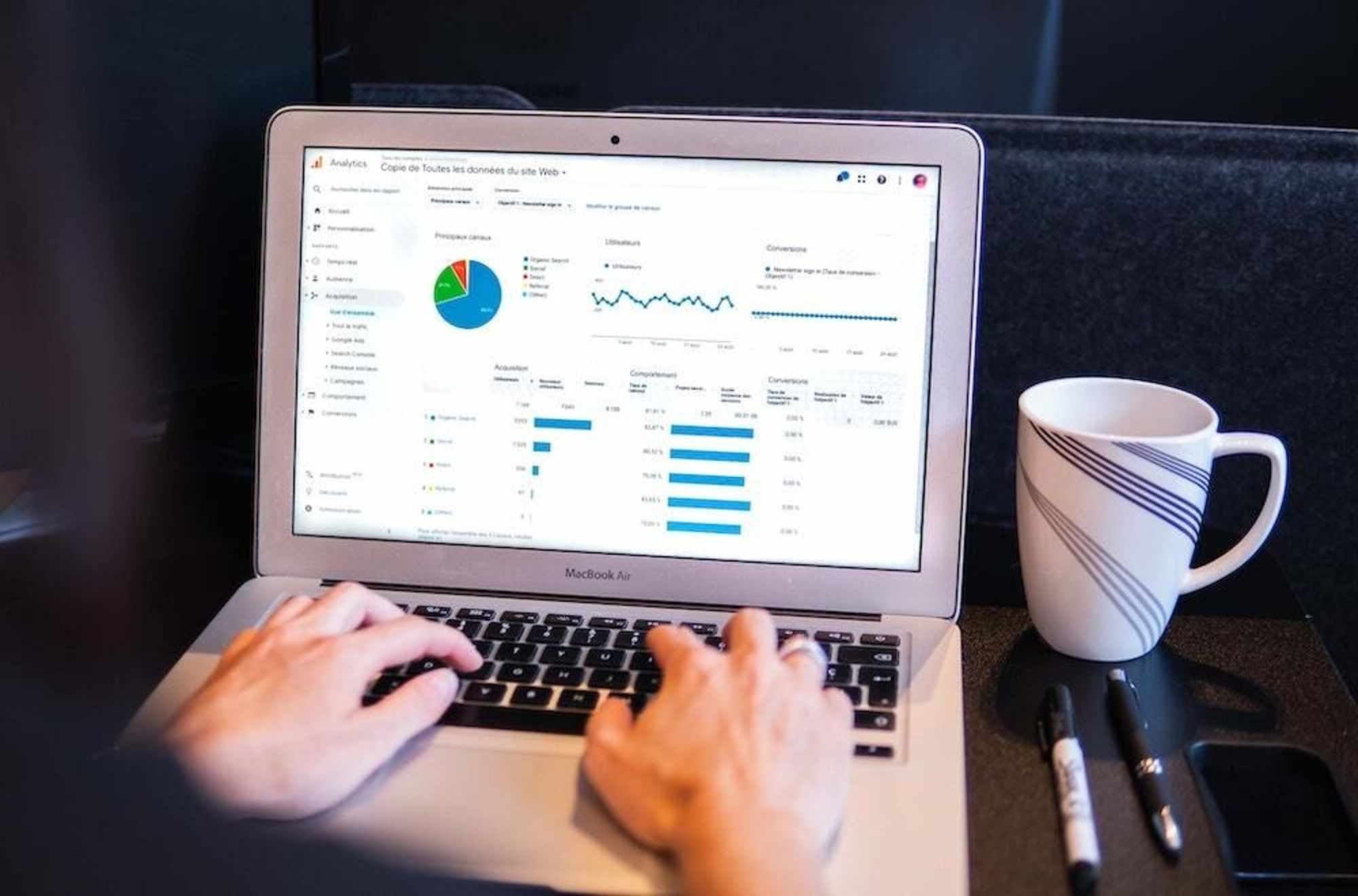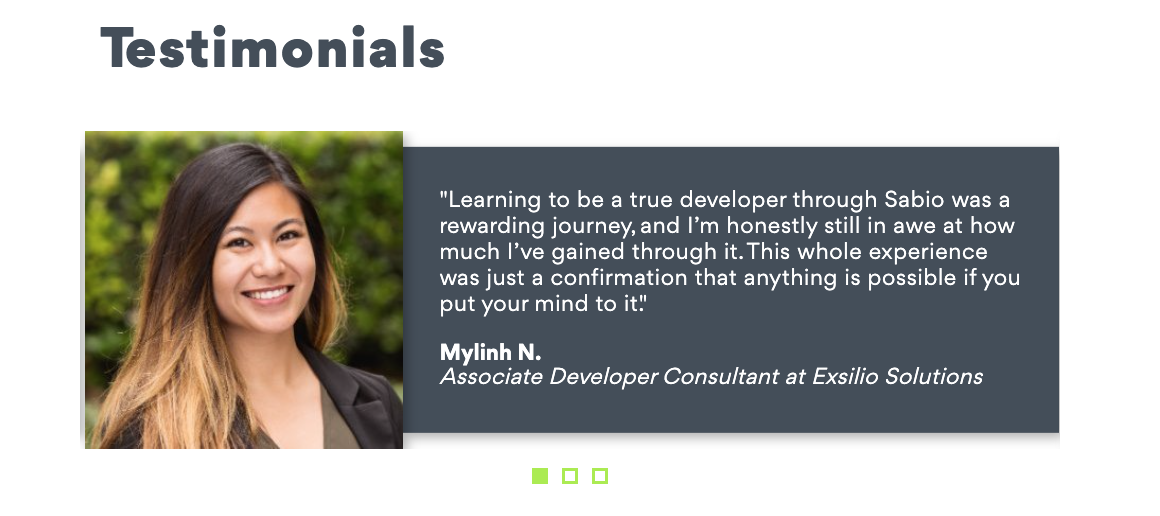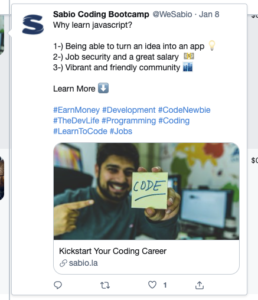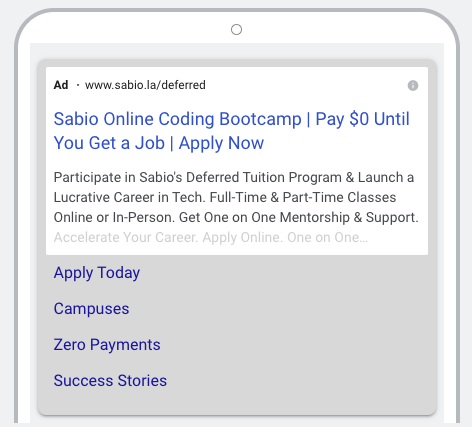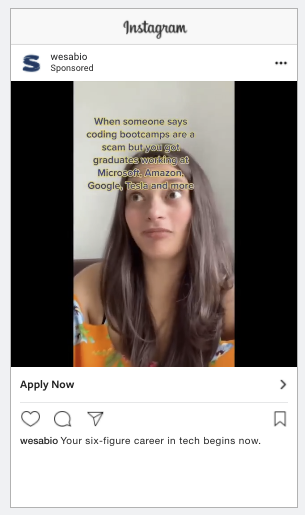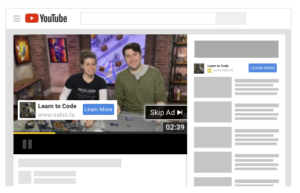From Google Ads to Reddit: How We Tested 7 Different Acquisition Channels to Get Better Applicants for Sabio
If you’re a founder, you face two major obstacles:
- Finding traction: proving that there’s a sustainable hunger for your product or service.
- Scaling: taking your proven concept and bringing it to the masses.
Together, these two obstacles are an impressive challenge. One we’ve built our business to help founders overcome. Over the past few years we’ve worked with all kinds of different businesses across a range of industries to help them figure this out.
In this post, we share our experimentation process and the original channels we chose to help an early-stage company acquire new users online.
The scenario:
Liliana, CEO of Sabio, approached Tuff in November 2020 with one goal:
“Can you help us acquire new students for our online coding bootcamp?”
Sabio has strong product market fit, growing revenue, consistent enrollments, and regularly gets feedback from graduates to refine their course curriculum. For a company at this stage, we knew our biggest opportunity was to test a variety of different channels to see which would bring us the best students (high quality leads) at the most efficient cost.
“The entire Tuff Team is amazing, which is no surprise because their leadership is exceptional. Ellen has put together one of the most amazing firms out there, and we are so happy to be working with TUFF.“ – Liliana Monge, CEO, Sabio (Read all Reviews on Google)
How to Find the Best Acquisition Channels for Your Business
Acquisition channels are diverse and plenty. With so many options, how can you create a channel strategy that will really accomplish your goals?
The first thing you need to do is focus on your users, not your channels. Who are you trying to get in front of and who is your target audience? Once you have this down on paper, channel selection becomes significantly easier.
In general, there are two types of targeting options — behavioral based and intent based. When it comes to behavioral targeting, think channels like Facebook and Instagram or TikTok. For these channels, you can get very specific with who you are targeting based on things like age, income, job titles, and interests. Clicks can be cheap and reach can be wide.
On the flip side, you also have intent based targeting. This could be a channel like Bing, Google, or YouTube. Intent based targeting means you can target based on search terms or people who express some intent to purchase or learn more about a service you might offer. Clicks can be expensive and conversion rates can be extremely high.
Our target audience: Post-graduate students between the ages of 21-27 who are looking for a career change.
Using the above, we looked at 30 different channels and ultimately decided on the below because we knew we’d be able to get in front of this group on each. We also had enough video creative to explore both YouTube and TikTok.
- Bing
- Quora
- YouTube
- Facebook & Instagram
- TikTok
Budget and Goals
We had two options on this account:
- Test all seven channels at once
- Test one channel at a time
We decided to test all channels at once for three reasons:
- We have a stacked team of experts. Among our full team of growth marketers we divided the work and put our best strategy and execution into each channel. A smaller team would run into trouble investing enough time and resources into all six channels without dividing resources and diluting focus.
- We had a healthy budget. Not every company can afford to actively use more than a handful of channels and, even so, it’s tough to figure out which ones are delivering the right customers. Because we had more than $25,000 a month to allocate to our paid efforts, we decided to test each channel, eliminate under performers, and scale up winners as we learned.
- We had an existing library of strong creative assets. For some intent-based channels like Bing or Google where ads are text-based, you don’t need a big inventory of graphics and videos. But for channels like YouTube, TikTok, and Facebook, you definitely want a library of creative assets to test and optimize. For Sabio, we had at least 15 different videos to support our efforts and knew we were unlikely to see creative fatigue right away.
TikTok
TikTok is new and growing fast. Because Sabio had such strong video creative and an active organic audience on TikTok already, we carved out $4,000/month for this channel for initial testing. Here were the initial videos we tested:
Video 1 | Video 2 | Video 3 | Video 4
TikTok brought us the most student applications for the lowest CPA. The volume was high but the quality of applicants was average.
As we continued to optimize on TikTok, three things became extremely important:
Dayparting
When we first launched ads on TikTok, all of our daily budget was being spent before 2 p.m. Our hunch was that our audience was most active on TikTok in the evenings, and we were missing valuable impressions.
We scheduled our ads to be served from 12 p.m. to 12 a.m., and our CPA dropped 34% because of this simple switch.
Approvals
TikTok’s ad policies are strict, and getting ads approved was definitely a challenge for Sabio, a brand that really exists to help people advance their careers. Sabio’s strongest value props are around potential salary, their tuition program, and job opportunities post-bootcamp. We had to be really strategic with our copy and video to get around some of TikTok’s ad policies.
Additionally, there are also strict guidelines for the landing page your TikTok ad drives to. Be sure to to study TikTok’s ad policies before launching campaigns to avoid potential disapprovals.
Pre-Paid
TikTok requires that advertisers pre pay a balance on their account, instead of retroactively billing the advertiser like other social channels. We quickly learned that it’s important to stay on top of the ad account balance making sure there were plenty of pre-paid funds.
Every time your account runs out of balance, your campaigns reset and results tend to dip for a day or two as the algorithm re-optimizes. To maintain consistent results, we recommend adding the entire monthly budget to your account at a time instead of small increments.
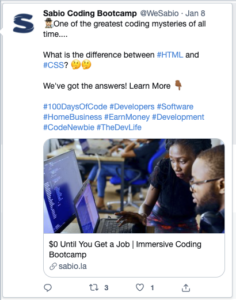
While only about 5% of all Tuff clients explore Twitter as a paid acquisition channel, because of the handle and hashtag targeting capabilities, we knew we needed to test this out and see if we could find potential developers and engineers. Here’s what this setup looked like:
- Optimized the campaigns for traffic
- Daily Budget: $95
- Audiences:
- Career Switch
- Women in STEM
- Coding Interests
- Gaming Interests
- CPC: $1.51
We tested several ad creatives on Twitter to see what would perform the best and we found that video ads had a 58% lower CPC but yielded lower quality site traffic compared to images and graphics. We optimized our campaigns so that the majority of our Twitter spend went to the top performing image ads.
While we had a few applicants come in during the first four weeks, we ultimately decided to kill this channel after six weeks of testing. The CPA was high, bounce rate high, and time on site was extremely low. We ditched it and reallocated the funds to Google and Bing.
Google Ads
For almost any business that gets searched online, Google Ads is a no brainer. For this channel, Sabio was already running campaigns and our big focus as a team was to get into the account and clean it up so that we could more efficiently drive scale. Almost immediately, we were able to find some quick wins.
We quickly noticed that over 75% of the conversions from Google Search campaigns in the previous three months had come from branded terms. Although branded search is a critical component to most brand’s search campaign structure, we knew that we needed to expand into non-branded campaigns to increase the volume of applications for Sabio.
Our initial keyword research also uncovered significant opportunities to add highly-targeted, long tail keywords into our campaigns. With high volume projected on these long tail keywords, we were able to stick primarily to exact-match targeting while also removing previous non-branded broad match keywords that were wasting a significant portion of the search campaign budget.
Over time, our keyword list has shrunk as we have gathered data, reviewed the search terms reports, and honed in on the exact terms we need to focus on as exact-match keywords.
Overall, our strategy on Google has been simple but effective:
- Avoid wasteful broad-match terms and general search queries by targeting long tail keywords
- Break out campaigns by location-focused KWs vs. remote to match the structure of the search and the website
- Create and break out a branded search campaign to capture all Sabio searches optimized for impression share
Within three months, we’ve been able to decrease the CPA by 36% while almost doubling the total amount of leads just by finding ways to eliminate waste.
Bing Ads
We think about Bing ads in a very similar way to Google. The intent is high and the searchers are already looking for a solution similar to Sabio.
The interesting thing about Bing is that it can be cheaper and less crowded. If we can get results on Google, we can almost guarantee that we’ll see the same results on Bing.
For Sabio, not the case. Bing was expensive and low scale. We tested for three months and ended up reallocating the spend elsewhere for Q2 based on initial learnings. In comparison, here’s what the costs looked like across both channels for the final two months of testing:
Although CPCs were slightly cheaper on Bing for the same keywords, the traffic quality was not nearly as strong as Google, resulting in Cost Per Application over 2x that of Google Search, and a conversion rate less than half.
With these results and sufficient testing spend already having been allocated to Bing, moving future funds over to other channels with lower conversion costs made sense.
Reddit is a smart strategy for very select, specific, and niche companies. It’s not a channel for everyone.
While we ended up killing Reddit after two months, we wanted to try this channel because we knew we could get ads (for a very low cost) in front of a specific audience and relevant subreddits.
Our big focus on Reddit was to get our campaign structure right. To do this, we started by split testing two different objectives: Traffic and Brand Awareness/Reach.
Like other social platforms, we wanted to test both campaign objectives to analyze how the metrics would truly shake out. For example, would the Traffic objective yield more clicks and lower CPCs as it is intended to? Or would our testing show that Brand Awareness was actually a better option for getting traffic from Reddit?
Interestingly, in our final month of testing, the Brand Awareness objective campaign outperformed the Traffic objective campaign in both of these top level metrics, yielding lower CPCs at about half the cost of the Traffic objective campaign, as well as a higher CTR. Without testing, we could very easily have assumed that the Traffic objective campaign would have been more effective at driving traffic, although the results tell a different story in this case.
We also decided to target four different subreddits: r/earnprogramming, r/coding, r/codinghelp, r/codingbootcamp. Over time we dropped the low performers and added in new subreddits for testing.
We also got specific with our creative. We didn’t want the ads to stand out on Reddit. We were constantly rotating in new creative ways depending on success from other channels.
Ultimately, we killed the channel due to low performance but here’s a look at the data to get an idea on how this might compare to a more traditional channel like Facebook or Google:
- Spend: $1,707
- Traffic: 1,839
- CPC: $0.82
- Applications: 10
- CPA: $170
- CVR: 0.54%
Facebook & Instagram
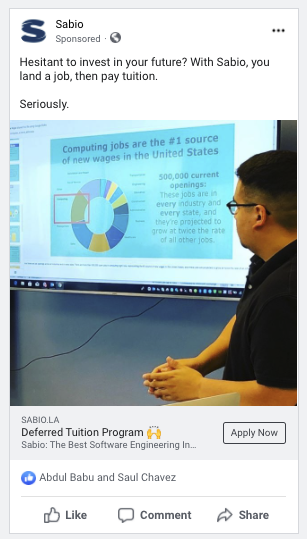
While we originally thought Facebook and Instagram ads would be an incredible channel for retargeting, it proved successful for both prospecting and retargeting, bringing us some our lowest CPAs.
Similar to other channels, our success was dependent on our optimization strategy. When we took over the account, the majority of the campaigns were being optimized for traffic. Within the first week, after configuring conversion goals and events within Facebook, we started testing out campaigns optimized for conversions. For Sabio, this meant a user clicking on an ad and filling out a form on the website. The results were drastic. Not only did the conversion-optimized campaigns drive more leads but the traffic was significantly higher quality when we analyzed the performance of each ad creative in Google Analytics.
Here’s how this works:
Your optimization strategy plays a significant role in performance on Facebook and Instagram. Audiences on the channel are typically millions of users in size, and it’s the algorithm’s job to prioritize who out of that audience will see your ad. By choosing certain optimizations (like conversions for example), you’re essentially telling the algorithm to go out and find users most likely to take that action (like filling out a Sabio application).
But in order for that to work properly, the conversion event has to have enough data to help the algorithm prioritize users in your audience. For some brands, there just isn’t enough conversion data available on their Facebook pixel to optimize for lower funnel events, and it’s better to optimize for traffic instead.
Facebook—along with TikTok—is now fueling two areas of our marketing funnel for Sabio. We’ve allocated spend to prospecting audiences on both channels to drive new traffic to the website as well as spend around 30% of the budget on retargeting campaigns to drive traffic back to the site to convert. These social channels sandwich our PPC campaigns on Google, YouTube, and Bing.
YouTube Ads
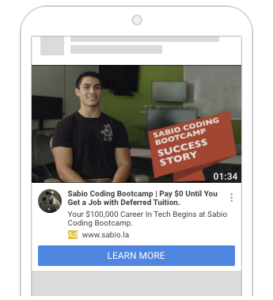
Last but not least, YouTube ads. This is one of the fastest growing channels and a personal favorite at Tuff.
For context, a few years ago (2019ish) maybe 10% of our clients were advertising on YouTube. Fast forward to today, almost every client we work with is actively running YouTube campaigns or has tested out the channel.
YouTube is great for so many reasons but in particular it can supercharge results for brands that have solid video assets because of the targeting capabilities. YouTube is like a hybrid of Google Ads (intent-based targeting) and Facebook Ads (behavioral-based targeting). You can get extremely specific with who you serve your ads to based on their actual search history and you can also leverage high-converting visual creative assets to reach them. It’s the best of both worlds.
For YouTube, we tested Video Action Campaigns and YouTube In-Stream Prospecting – the In-Stream tanked and we killed it quick. The Video Action campaigns were, and have continued to be, super effective.
We tested multiple videos and quickly isolated top performers in order to lower cost and drive up quality. Here’s an example of a two-week creative test in which we sought to understand which video would resonate the most (and drive conversions):
After isolating creative and campaign type, we then shifted our focus to additional targeting optimizations. Within a few weeks, we were able to test targeting placements and channel placements, discovering that for this unique account, topics are significantly more effective than channels. Here’s a peek:
- Topics = $46.24 CPA
- Channels = $281 CPA
After this, we layered on retargeting and have continue to optimize the follow areas to improve performance:
- Campaign Type
- Audience Targeting
- Creative
What’s next? Strategy for Q2
We started our partnership with Sabio at the end of 2020 and we’re actively building on our strategy for Q2. Our mission stays the same: Can we drive more applications on the Sabio website at an efficient cost?
Based on our learnings from the last three months, here our some of the initial optimizations we plan to apply to our next round of campaigns as a team:
- Allocate at least 50-60% to the intent-based channels (they’re higher cost but higher quality)
- Kill Reddit, Bing, and Twitter. Move forward with TikTok, Google Ads, Facebook, Instagram, and YouTube
- Continue to work on attribution so we can get an even better understanding of quality (vs quantity)
- Test two new channels: LinkedIn and Snapchat (stay tuned!)
As we’ve outlined above, the first step is defining the user acquisition channels that will or have the biggest impact on growth, and working tirelessly to test and validate the combination that will have the biggest impact on your business. It can seem overwhelming at the start, but testing and optimization should become part of your growth DNA. What might seem like a steep learning curve will turn into a path with long-term payoff when you get it right.

Ellen is the founder at Tuff and one of the team’s core growth marketers. She is a versatile marketer with expertise in multiple channels – from ppc to seo to email to others – responsible for the experiments and testing. She is happiest when she’s on the ski hill or outside pointing her mountain bike downhill.

